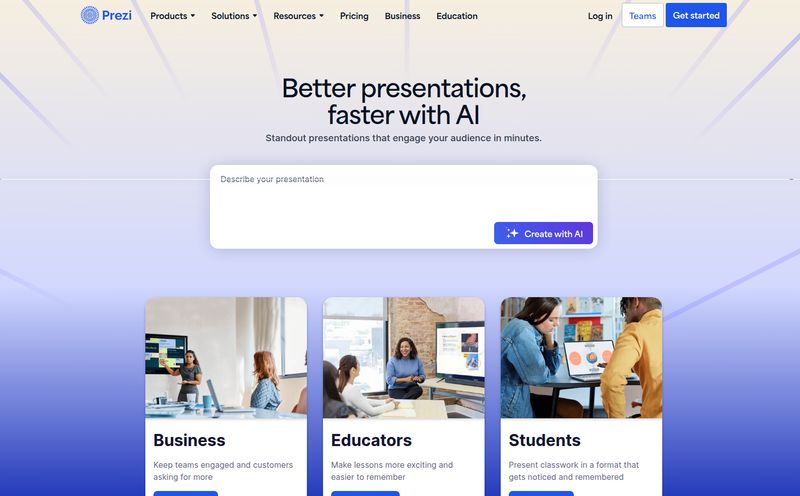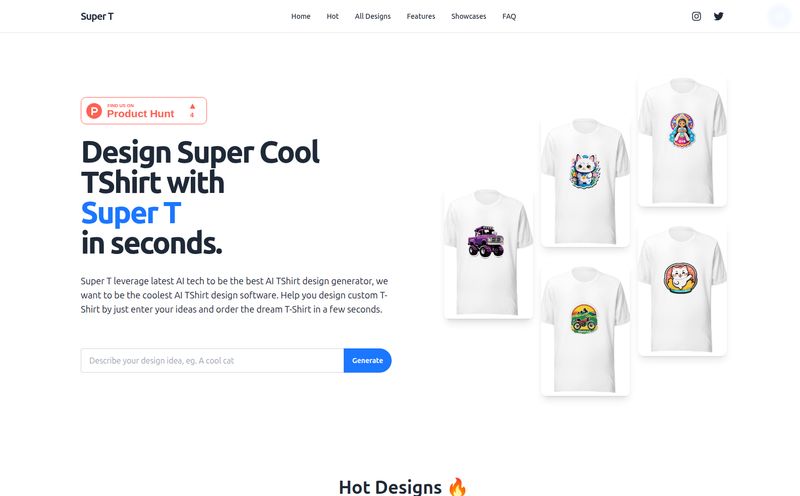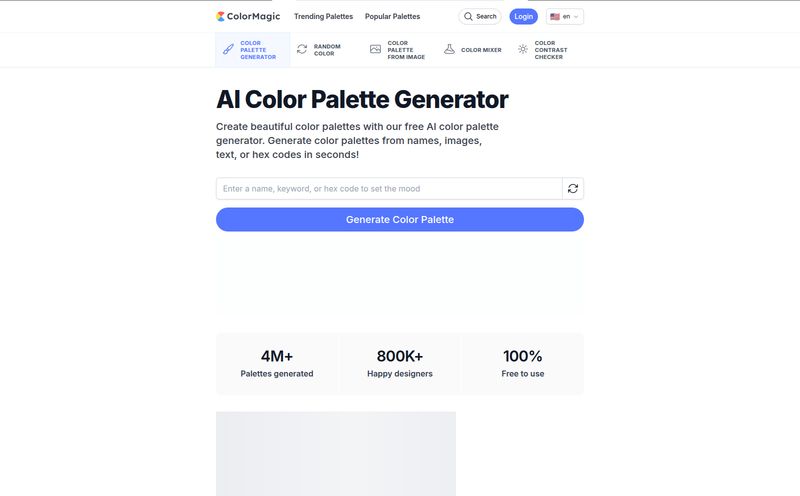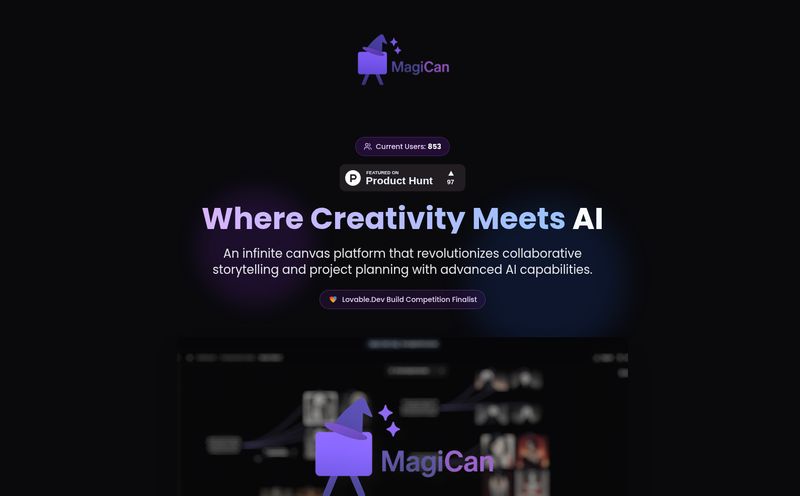I’ve been in the SEO and digital marketing world for years, but my secret passion has always been design. I’ve seen trends come and go, from the sterile minimalism of the 2010s to today's cozy grandmillennial craze. And through it all, one thing has remained constant: the sheer, soul-crushing time it takes to create a good design render. I still have flashbacks to nursing a render on an overheating laptop, praying to the tech gods that it wouldn’t crash before a client meeting. The process was slow, expensive, and often a bottleneck.
So when the AI wave started crashing into every industry, I was skeptical but curious. Could a machine really understand the subtleties of light, texture, and mood? Then I stumbled upon HomeVisualizer.ai. The name is a bit on the nose, sure, but its promise was bold: "Visualize Your Home Instantly." Okay, color me intrigued. I decided to take it for a spin, and honestly, it’s one of the few AI tools lately that’s made me sit up and say, “Huh. This could actually change things.”
So, What Exactly is HomeVisualizer.ai?
Think of it as a design assistant who's had way too much coffee and can spit out ideas faster than you can describe them. In simple terms, HomeVisualizer.ai is an AI-powered platform where you upload an image of a space, and it redesigns it in seconds. And I’m not just talking about a polished, professional photo. This is the cool part. You can feed it a blurry photo from your phone, an architectural elevation, or even a rough napkin sketch you drew while waiting for your latte.
You then tell the AI what you want. You can pick from a list of predefined styles—like Modern, Scandinavian, or Industrial—or you can get more specific. It's built for professionals like interior designers and architects, but it’s straightforward enough for a real estate agent trying to virtually stage a property or even a homeowner who just can't decide on a paint color. It’s about breaking down that initial barrier of imagination and getting straight to the visuals.
Putting it to the Test: My First Impressions
Signing up was simple, and the interface is clean. No confusing menus or a million buttons to click. It gets right to the point: upload your image and start designing. Here’s what stood out to me.
The Magic of Instant Visualization
The speed is the first thing you'll notice. It’s fast. Ridiculously fast. I uploaded a picture of my own decidedly “undesigned” home office, selected a ‘Mid-Century Modern’ style, and had four different visual options in under a minute. For anyone who has waited hours (or days) for a traditional 3D render, this feels like actual sorcery. This speed completely changes the client feedback loop. Instead of presenting one or two painstakingly crafted options, you can generate a dozen variations during a client meeting. That’s a powerful shift.
Beyond Basic Styles: Digging into the Design Modes
This is where HomeVisualizer.ai really starts to flex. It’s not just a one-trick pony. It has a few different modes that offer a ton of creative control.
- Auto Style: This is the most straightforward mode. Pick a style from their list, and the AI does the rest. It’s great for quick ideation or when a client says, “Just show me what it would look like as a coastal cottage.”
- Style Fusion: This feature is my personal favorite. You upload your room image, AND an inspiration image. Maybe you saw a hotel lobby on Pinterest with a specific vibe you love. The AI then intelligently blends the style of your inspiration into your actual space. It’s like creating a digital mood board that actually paints the room for you.
- Custom Requests: If you're a control freak like me, this is your jam. You can type in specific instructions like, “add a dark green velvet sofa, oak flooring, and brass light fixtures.” The AI will then attempt to incorporate those specific elements. It’s not always perfect, but its ability to interpret natural language requests is seriously impressive.
From Sketch to Stunning Reality
The ability to work from a simple sketch is a huge win for the early-stage design process. It bridges that gap between an abstract idea and a tangible concept. Imagine sketching a basic floor plan for a kitchen remodel, uploading it, and instantly seeing it rendered as a fully-realized 'Modern Farmhouse' kitchen. It helps clients (and even yourself) see the potential in a space long before any real work begins. This is a far cry from the old days of trying to explain your vision with hand-waving and vague descriptions.
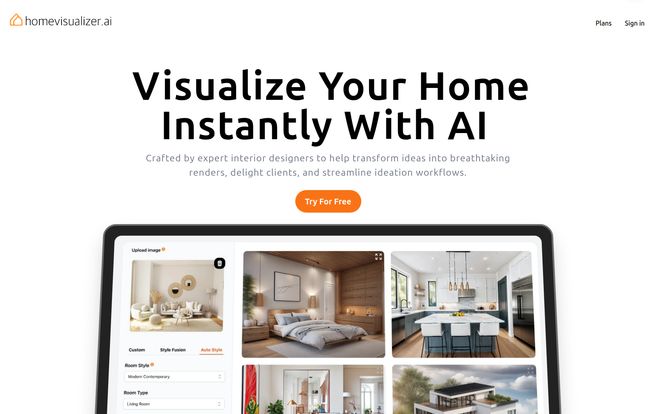
Visit HomeVisualizer.AI
What I Loved and What I'd Tweak
No tool is perfect, right? After playing around with it for a while, I’ve got a pretty good handle on its strengths and where it has room to grow. It’s not about finding a tool that does everything, but finding the one that does what you need it to do, and does it well.
The Wins: Where It Really Shines
The main advantage is, without a doubt, the time saved. What used to be a whole day's work can now be done in a coffee break. This frees you up to focus on the bigger picture—client relationships, sourcing materials, and the overall creative direction. The variety of styles it can produce is also a massive plus, pushing you out of your own design comfort zone. And I can’t overstate the value of helping a client see what you’re talking about. It reduces misunderstandings and gets you to a final approved design much, much faster.
A Few Caveats to Consider
Now for the reality check. First off, this is a subscription service. There’s no free-forever plan, which might be a bummer for some. You have to be willing to invest. Secondly, the Standard plan comes with limited cloud storage. If you’re a power user like me who wants to save every single variation (just in case!), you might find yourself hitting that limit. It’s a clear nudge to upgrade to the Pro plan, which offers unlimited storage. It’s a classic SaaS business model, and while it's not a dealbreaker, it’s something to be aware of before you jump in.
Let's Talk Money: HomeVisualizer.ai Pricing
So, what's the damage? The pricing structure is pretty clear and tiered for different types of users. It’s worth noting you can save a good chunk of cash (up to 35%, according to their site) by paying yearly instead of monthly.
| Plan | Price (Billed Annually) | Key Features | Best For |
|---|---|---|---|
| Standard | $12 /month | 250 renders/month, Limited Storage, Personal License | DIY enthusiasts, students, or designers just starting out. |
| Pro | $21 /month | 1000 renders/month, Unlimited Storage, Commercial License | Freelance designers, stagers, and small agencies. |
| Business | $75 /month | 5000 renders/month, Unlimited Storage, Commercial License | Larger design firms, real estate brokerages, and high-volume users. |
In my opinion, the Pro plan is the real sweet spot. For about the price of a few fancy coffees a month, you get a commercial license (crucial for client work), a hefty 1000 renders, and unlimited storage. The Standard plan is a great entry point, but the limited storage and personal-use-only license will be restrictive for most professionals.
Who is This Tool Really For?
While the name screams “homeowner,” I think the biggest impact will be felt by professionals.
- Interior Designers: This is a no-brainer. Speed up your ideation, create more options for clients, and get approvals faster.
- Real Estate Agents & Stagers: Empty rooms are hard to sell. Use this to create stunning virtual staging in minutes. Show potential buyers what a vacant house could look like. It's way cheaper and faster than physical staging.
- Architects: Quickly add interior context to your structural designs. It helps in presenting a more complete vision of a project from the earliest stages.
- Ambitious DIYers: Yes, it’s also for you! If you’re planning a big renovation, this tool can save you from costly mistakes by letting you visualize everything first.
Final Thoughts: Is HomeVisualizer.ai a Game Changer?
Look, AI isn't going to replace a designer's trained eye or their ability to manage a complex project. It’s not going to source your furniture or deal with contractors. But that’s not the point. What HomeVisualizer.ai does is automate the most tedious, time-consuming part of the creative process: initial visualization.
It acts as a creative catalyst. It’s a tool that augments your own creativity, not one that replaces it. It allows for more experimentation, better communication, and ultimately, a more efficient workflow. For me, any tool that gives me back time and makes my clients happier is a win. And this one definitely does. It’s not perfect, but it's a powerful and frankly, exciting, glimpse into the future of design work.
Frequently Asked Questions
- How does HomeVisualizer.AI actually work?
- It uses a form of generative AI, likely trained on a massive dataset of interior design images. When you provide an input image and a style prompt, the AI analyzes the geometry of your room and re-imagines the surfaces, lighting, and objects based on the style you’ve chosen.
- Can I use HomeVisualizer.ai for commercial projects?
- Yes, but you’ll need the Pro or Business plan. These plans include a commercial license, which gives you the right to use the generated images for client work, marketing, and other business purposes.
- What kind of images can I upload?
- You can upload a wide variety of inputs, including photos of existing rooms, architectural renderings and elevations, and even hand-drawn sketches. The more clear the lines and perspective are, the better the result will likely be.
- Is there a free trial?
- Based on their website, there doesn't appear to be a free trial offered. However, the monthly billing option on the Standard plan could be a low-cost way to test it out for a month before committing to a yearly plan.
- What happens if I cancel my subscription?
- The plans are listed as “Cancel Anytime.” Typically with services like this, if you cancel, your plan will remain active until the end of your current billing period (monthly or yearly), after which you'll lose access to the premium features.
- Is my data secure with HomeVisualizer.ai?
- The platform's homepage mentions a focus on data security, stating they will never sell your data for ad protection. This is a good sign for professionals who are uploading client-sensitive project images.
